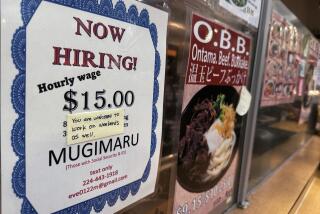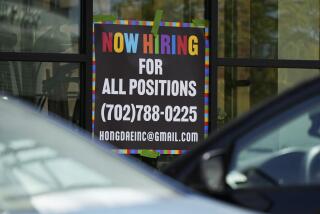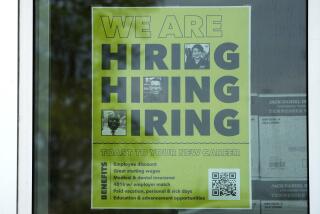Factory Orders Tumble; Unemployment Claims Up
WASHINGTON â Factory orders for durable goods plunged in September for the second straight month, and claims for unemployment insurance climbed to the highest level since May in what analysts cited as fresh signs of a weakening economy.
âIf you wanted to shift the tea leaves in the most optimistic way, thereâs not much to make you feel good,â said Joel Prakken, an economist with Laurence H. Meyer & Associates, a St. Louis forecasting service.
The Commerce Department said orders for durable goods--usually expensive items expected to last more than three years--fell 3.2%, paced by the steepest decline in defense orders in more than seven years.
Orders also sank a revised 4.1% in August, even worse than the previously estimated 3.9% drop.
âSeptember orders for durables reveal a recovery that is still on the skids and shows few signs of strength,â said economist John M. Albertine, head of a Washington forecasting company.
âThis gloomy-looking figure, in conjunction with other statistics such as higher unemployment claims . . . indicate the sustainability of the expansion is in question,â said Sung Won Sohn, an economist with the Norwest Corp. in Minneapolis.
The Labor Department said Thursday that new applications for unemployment insurance rose 29,000, to 452,000, during the week ending Oct. 12, the highest level since May.
And the Federal Reserve said Wednesday that a survey by its regional banks pictured a âweak or growing slowlyâ economy in September and early October, with manufacturing âstill improving, although at a slower pace in some areas.â
âSo far, industrial production really has been the main source of economic strength,â Sohn said. âBut this durable goods report indicates that production may not go up and may falter.â
The Fed survey also found that the Boston and St. Louis regions ânoted growing weakness in defense industriesâ--a finding reflected in the durable goods report.
The often volatile defense orders plummeted 48.9%, the steepest drop since a 51% decline in April, 1984. Orders totaled $5.5 billion, the lowest level since falling to $5 billion in November, 1990.
Some analysts said the reduction in defense spending associated with the end of the Cold War will continue to plague the manufacturing sector.
âItâs part of a trend,â Sohn said.
Excluding the defense category, orders rose 1.1%.
The transportation sector, which also varies widely from month to month, sank 13.9% to $29.6 billion, on top of a 9.1% tumble in August. Excluding that sector, orders rose 0.9%.
The report said decreases in aircraft, shipbuilding and tanks offset an increase in motor vehicles.
But the automobile industry reported steep declines in sales during the first 20 days of October, the beginning of the new model year. Many analysts expect auto sales to remain weak and thus curtail new orders.
Unfilled orders, another barometer of economic health, decreased 0.8%, the first decline in three months. Falling backlogs often mean slack demand and subsequent declines in output.
Shipments of durable goods increased 0.7% to $125.3 billion, the sixth consecutive increase, although the level remained below the $127.7 billion posted a year ago.
Still, the report said orders for non-defense capital goods excluding aircraft rose 8.2% to $26.9 billion--the biggest gain since a 9.6% advance in January, 1989. This gauge of business plans to expand and modernize fell 2.1% a month earlier.
Among the major orders sectors, primary metals also fell, down 5.1% to $10.7 billion after dipping 1.6% the previous month.
But orders for electronic and other electrical equipment rose 8.6% to $17.6 billion, wiping out a 7.7% loss a month earlier. Industrial machinery and equipment orders also rose, up 4.6% to $21.3 billion after slipping 0.9% in August.
Durable Goods
New orders in billions of dollars, seasonally adjusted
Sept., â91: 121.5
Aug., â91: 125.5
Sept., â91: 126.9
Source: Commerce Department
More to Read
Inside the business of entertainment
The Wide Shot brings you news, analysis and insights on everything from streaming wars to production â and what it all means for the future.
You may occasionally receive promotional content from the Los Angeles Times.










